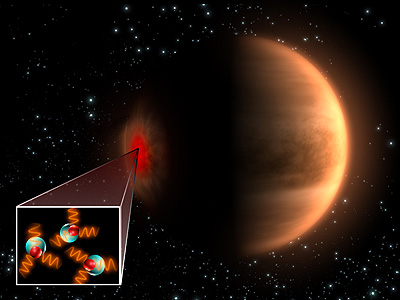Hydroxyl is made up of a hydrogen and oxygen atom each. It has been found on another planet for the first time - in the upper reaches of the atmosphere of Venus, some 100 km above the surface - by Venus Express’s Visible and Infrared Thermal Imaging Spectrometer, VIRTIS. It is thought to be important for any planet’s atmosphere because it is highly reactive. On Earth it has a key role in purging pollutants from the atmosphere.
The OH “radical” is a very special and reactive molecule, which is unusual in conventional chemistry because of its reactivity. This detection gives scientists an important new tool to unlock the workings of Venus’s dense atmosphere.
The elusive molecule was detected by turning the spacecraft away from the planet and looking along the faintly visible layer of atmosphere surrounding the planet’s disc. The instrument detected the hydroxyl molecules by measuring the amount of infrared light that they give off.

Just like the Earth, the atmosphere of Venus emits a very weak light caused by various processes occurring in the upper atmosphere. On Earth, this weak emission of light, known as airglow, was discovered in 1868. It is also referred to as nightglow because it can only be seen during the night. In the daytime, it is hidden by the much stronger light because of sunlight scattering.
Observing atmospheric airglow is a major tool for inferring the composition and chemistry of the upper atmospheres of planets. For example, in Earth's atmosphere, the airglow from the OH radical, which was detected in 1948, was later found to play an important role in purging the atmosphere of pollutants harmful to the biosphere. Theoretical studies show that the hydroxyl airglow also plays an important role in the chemistry of Mars' atmosphere, but it has not yet been detected.
On Venus, airglow emissions have already been observed coming from nitrogen monoxide (NO) and oxygen dioxide (O2). The VIRTIS team now reports measurements of four airglow emission lines: two from OH at 1.44 and 2.80 microns and two from O2 at 1.27 and 1.58 microns.
The band of atmosphere in which the glowing hydroxyl molecules are located is very narrow; it is only about 10 km wide. By looking at the limb of the planet, Venus Express looked along this faint atmospheric layer, increasing the signal strength by about 50.
The reactive molecule has been seen around comets, but the method of production there is thought to be completely different from the way it forms in planetary atmospheres.
“Because the venusian atmosphere had not been studied extensively before Venus Express arrived on the scene, we have not been able to confirm much of what our models tell us by observing what is actually happening. This detection will help us refine our models and learn much more,” says one of the Principal Investigators of the VIRTIS experiment, Giuseppe Piccioni, from the Istituto di Astrofisica Spaziale e Fisica Cosmica in Rome, Italy.
On Earth, the glow of hydroxyl in the atmosphere has been shown to be closely linked to the abundance of ozone. From this study, the same is thought to be true at Venus. Now, scientists can set about estimating the amount of ozone in the planet’s atmosphere.
Venus Express has shown that the amount of hydroxyl at Venus is highly variable. It can change by 50% from one orbit to the next and this may be caused by differing amounts of ozone in the atmosphere.
“Ozone is an important molecule for any atmosphere, because it is a strong absorber of ultraviolet radiation from the Sun,” says Piccioni. The amount of the radiation absorbed is a key parameter driving the heating and dynamics of a planet’s atmosphere. On Earth, it heats the stratosphere (layer of the atmosphere) making it stable and protecting the biosphere from harmful ultraviolet rays.
Computer models will now be able to tell how this jump and drop in ozone levels over short intervals affects the restless atmosphere of that world.
“Venus Express has already shown us that Venus is much more Earth-like than once thought. The detection of hydroxyl brings it a step closer,” says Piccioni.
He and his colleagues are only reporting the initial detection from a few orbits in their latest paper. They are working on the analysis of data from about 50 other orbits and more observations will follow.






Comments